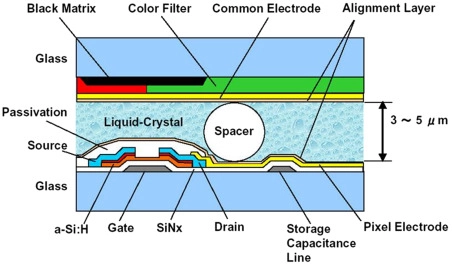Introduction
In the ever-evolving landscape of Digital displays, liquid crystal displays (LCDs) have firmly established themselves as an indispensable technology that has revolutionized the way we interact with visual information. From the sleek screens of our smartphones and laptops to the massive displays adorning public spaces, LCDs have become an integral part of our daily lives.
At the heart of an LCD lies a unique and fascinating technology that harnesses the properties of liquid crystals, a state of matter that combines the fluidity of liquids with the molecular order of solid crystals.
Liquid Crystal Displays
Liquid crystal displays (LCDs) have become an integral part of our daily lives, found in everything from smartphones and laptops to televisions and digital signage. At the core of this ubiquitous technology lies a unique and fascinating material known as liquid crystals.

Liquid crystals are a state of matter that exhibits properties of both liquids and solid crystals. They possess a remarkable ability to change their optical properties in response to an applied electric field, allowing for precise control over the transmission and modulation of light. This characteristic forms the foundation of LCD Technology, enabling the creation of stunning visual displays.
The journey of LCDs began in the late 1960s when researchers at RCA’s David Sarnoff Research Center discovered a unique electro-optical effect in liquid crystals. This discovery paved the way for the development of the first monochrome LCD displays, which were initially used in digital watches and calculators.
Now, understanding this concept is simple and entertaining for Hasons. Using the Hason website you can always stay one step ahead in your job, business, or studies by purchasing New Age Desktops and i3 Intel Core Processor Desktop starting from 15000/-. Monitors, CPUs, and Gaming Desktop are also available. Register on Hasons and order your Tech Partner Now. Get exciting offers and benefits on your every purchase. Contact us so our support team can guide you in purchasing the right Tech Partner.
Hasons Nova Pro
22-Inch Ips Monitor | Hasons With 1920*1080 Px
Electro-Optical Effects in Liquid Crystals
The remarkable properties of liquid crystal displays (LCDs) stem from the unique electro-optical effects exhibited by liquid crystals. These effects govern the interaction between liquid crystals and light, enabling precise control over the transmission and modulation of light through the LCD panel.

One of the most fundamental electro-optical effects in liquid crystals is the dielectric anisotropy effect. Liquid crystal molecules have an elongated, rod-like shape, and their polarizability (the ability to be polarized by an electric field) varies depending on the orientation of the molecules relative to the applied electric field.
Twisted Nematic Displays
Twisted nematic (TN) displays are one of the most widely used and well-established types of liquid crystal displays (LCDs). These displays rely on the twisted nematic effect, a unique phenomenon observed in liquid crystals, to achieve their remarkable visual capabilities.
In a TN display, the liquid crystal molecules are arranged in a twisted helical structure between two polarizing filters. This twisted structure causes the polarization of light to rotate as it passes through the liquid crystal layer. When no electric field is applied, the polarization of light is rotated by 90 degrees, allowing it to pass through the second polarizing filter and creating a bright pixel on the display.
Super Twisted Nematic Displays
Super twisted nematic (STN) displays are an advanced variation of the traditional twisted nematic (TN) liquid crystal displays (LCDs). These displays leverage a unique twist angle in the liquid crystal layer to achieve improved performance and visual characteristics.
In STN displays, the liquid crystal molecules are arranged in a helical structure with a twist angle greater than 90 degrees, typically ranging from 180 to 270 degrees. This increased twist angle provides several advantages over standard TN displays, including improved color reproduction, higher contrast ratios, and wider viewing angles.
Thin-Film Transistor Displays
Thin-film transistor (TFT) displays represent a significant advancement in liquid crystal display (LCD) technology, offering superior image quality, higher resolutions, and faster response times compared to traditional passive-matrix displays. These displays employ an active-matrix addressing scheme, which uses an array of thin-film transistors to control the individual pixels on the display.
In a TFT display, each pixel is controlled by its own dedicated transistor, which acts as a switch to turn the pixel on or off. This active-matrix addressing method ensures that each pixel maintains its desired state until it is refreshed, resulting in a more stable and consistent image compared to passive-matrix displays, where the entire row or column is refreshed at once.
Other Transmissive Nematic Displays
While twisted nematic (TN) and super twisted nematic (STN) displays are the most widely used types of liquid crystal displays (LCDs), there are several other transmissive nematic display technologies that have emerged to address specific needs and Applications. These technologies leverage the unique properties of nematic liquid crystals to achieve different levels of performance and visual characteristics.
One notable example is the in-plane switching (IPS) display technology. IPS displays are known for their superior color reproduction and wide viewing angles, making them ideal for applications that require accurate color rendering and consistent image quality from multiple viewing positions.
Reflective Displays
In the realm of liquid crystal displays (LCDs), reflective displays offer a unique and energy-efficient approach to displaying information. Unlike transmissive displays, which rely on a backlight to illuminate the screen, reflective displays utilize ambient light or external light sources to produce visible images. This technology has found applications in various sectors, including e-readers, electronic paper displays, and certain types of outdoor signage.
The operating principle of reflective displays is based on the ability of liquid crystals to modulate the polarization of light. In these displays, a reflective surface, typically a metallic layer or a specialized polymer film, is placed behind the liquid crystal layer. When ambient light hits the display, it passes through the liquid crystal layer, where its polarization is modulated according to the alignment of the liquid crystal molecules.
Projection Displays
Projection displays are a unique category of liquid crystal display (LCD) technology that utilizes a combination of LCD panels and projection systems to create large, high-resolution images. These displays have found widespread use in various settings, including home theaters, classrooms, conference rooms, and large-scale digital signage applications.
 The core concept behind projection displays is the use of an LCD panel as a spatial light modulator, which modulates the intensity and color of light passing through it. This modulated light is then projected onto a screen or surface using a specialized projection system, creating a magnified and highly visible image.
The core concept behind projection displays is the use of an LCD panel as a spatial light modulator, which modulates the intensity and color of light passing through it. This modulated light is then projected onto a screen or surface using a specialized projection system, creating a magnified and highly visible image.
Smectic LCDs
While most liquid crystal displays (LCDs) on the market today utilize nematic liquid crystals, a lesser-known but promising technology involves the use of smectic liquid crystals. Smectic LCDs offer unique properties and advantages that make them attractive for certain applications, particularly in the fields of high-performance displays and optical computing.
Smectic liquid crystals are characterized by a layered structure, where the molecules are arranged in well-defined planes or layers. This layered arrangement provides several advantages over the more commonly used nematic liquid crystals, including faster response times, higher contrast ratios, and the ability to achieve bistable states.
Smectic LCDs
However, smectic LCDs also face some challenges that have hindered their widespread adoption. One of the main challenges is the difficulty in achieving uniform alignment of the smectic layers over large areas, which can lead to defects and non-uniformities in the display.
For instance, smectic LCDs have shown potential in the field of optical Computing, where their fast response times and bistable states can be exploited for optical data processing and storage.
Conclusion
As we reach the conclusion of our comprehensive exploration into the fascinating world of liquid crystal displays (LCDs), it becomes evident that this technology has truly revolutionized the way we interact with visual information. From the humble beginnings of monochrome displays in digital watches and calculators to the stunning high-resolution displays that adorn our modern devices, LCDs have undergone a remarkable journey of innovation and advancement.
At the core of this remarkable Technology lies the unique properties of liquid crystals, a state of matter that bridges the gap between liquids and solid crystals. These liquid crystals possess the ability to alter their optical properties in response to an applied electric field, enabling precise control over the transmission and modulation of light.
| If you are reading Liquid Crystal Display Blog, then also check our other blogs: | |
| Types of Virtual Reality | Types of Computer Security |
| Storage Device | Application of GPS |
Liquid Crystal Display
- What is an LCD?An LCD, or liquid crystal display, is a type of flat-panel display technology that uses liquid crystals to modulate light and create visible images. LCDs are widely used in various electronic devices, including smartphones, laptops, televisions, and digital signage.
- How does an LCD work?LCDs work by controlling the orientation of liquid crystal molecules, which are sandwiched between two polarizing filters. When an electric field is applied, the liquid crystals change their alignment, altering the polarization of light passing through them. This modulation of light determines the brightness and color of each pixel on the display.
- What are the advantages of LCDs?LCDs offer several advantages over other display technologies, including:
- Energy efficiency: LCDs consume less power compared to traditional CRT displays, making them suitable for portable devices.
- Slim and lightweight design: LCDs are thin and lightweight, allowing for compact and sleek devices.
- High resolutions: LCDs can achieve high resolutions, providing sharp and detailed images.
- Wide viewing angles: Advanced LCD technologies, like IPS and VA, offer wide viewing angles with minimal color shift or contrast degradation.
- Long lifespan: LCDs have a longer lifespan compared to other display types, with minimal degradation over time.
- What are the different types of LCDs?There are several types of LCDs, each with its own unique characteristics and applications:
- Twisted Nematic (TN): The most common and cost-effective LCD type, known for fast response times but limited color reproduction and viewing angles.
- In-Plane Switching (IPS): Offers superior color reproduction and wide viewing angles, making them suitable for professional graphics work and multimedia applications.
- Vertical Alignment (VA): Provides high contrast ratios and fast response times, ideal for video playback and gaming.
- Super Twisted Nematic (STN): An advanced variation of TN displays with improved color reproduction and wider viewing angles.
- Reflective: Energy-efficient displays that utilize ambient light or external light sources, suitable for e-readers and outdoor signage.
- Projection: Utilize LCD panels as spatial light modulators to create large, high-resolution images for applications like home theaters and digital signage.
- Smectic: Employ smectic liquid crystals, offering fast response times, high contrast ratios, and bistable states, useful for high-performance displays and optical computing.
- Limited viewing angles (for TN displays): Image quality can degrade at extreme viewing angles for some LCD types, like TN displays.
- Backlight bleeding: In some cases, backlight bleeding can occur, causing light to leak through the edges or corners of the display.
- Response time limitations: While faster than previous technologies, LCDs may still experience some motion blur or ghosting in fast-moving scenes.
- Color accuracy: Depending on the LCD type, color accuracy may vary, and some professional applications may require additional calibration.

